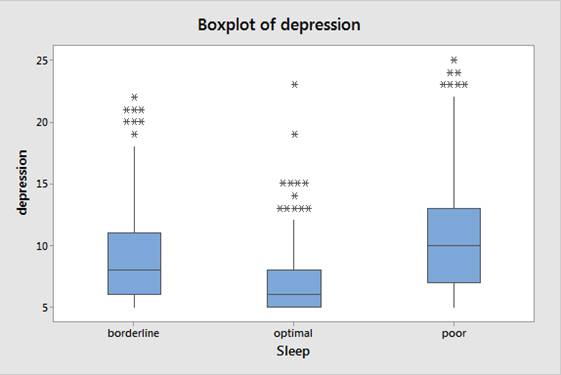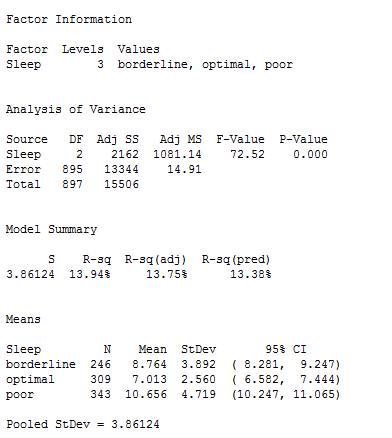
a.
To compare: The depression scores for the three qualities of sleep through a graph using the four-step process in data analysis and ANOVA.
a.
Answer to Problem 27.33E
The comparison of the depression scores for the three qualities of sleep is shown using MINITAB.
Output using the MINITAB software is given below:

At least one of the sleep qualities has different population
Explanation of Solution
Given info:
The dataset shows the quality of sleep and depression scores and here dataset of first seven individuals from a sample of 898 students.
| Quality of sleep: | poor | poor | border | poor | poor | optimal | border |
| Depression score: | 5 | 8 | 5 | 11 | 7 | 7 | 10 |
Justification:
The four-step process in data analysis is as follows,
Plan:
Check the condition and formulate a statistical question that can be answered with data, by any survey or poll. This is the most important step in the process. Here, the survey included questions on the sleep quality, moods, academic performance, physical health, and psychoactive drug use.
Collect:
Implement the plan to collect data through observations, interviews, questionnaires, databases, samplings, experimentation, or surveys. Here, the survey completed on a random sample of 898 students between the ages of 20 and 24 at a university. On the Pittsburgh Sleep Quality Index, students scoring less than or equal to 5 on index are classified as optimal sleepers, students scoring a 6 or 7 are classified as borderline, and those scoring over 7 are classified as poor sleepers.
Process:
Organize and summarize the collected data by graphical or numerical methods. Graph the numerical data using histograms, dot plots or box plots, and analyze the result.
Boxplot:
Step by step procedure to obtain boxplot using the MINITAB software:
- Choose Graph > Boxplot.
- Under One Y, choose With Groups, and then click OK.
- In Graph variables, select the column of depression.
- In Categorical variables for grouping, select the column of Sleep.
- Click OK.
Output using the MINITAB software is given below:

ANOVA:
Step by step procedure to obtain ANOVA using the MINITAB software:
- Choose Stat > ANOVA > One-Way.
- In Response, select the column of depression.
- In Factor, select the column of Sleep.
- Click OK.
Output using the MINITAB software is given below:

From the output, the standard deviation for borderline
The standard deviation must satisfy the rule of thumb.
The value 1.84 is less than 2. So, the condition is satisfied.
Thus, the ANOVA is used to compare the mean lengths for the three populations.
The boxplot shows that all the groups are having the outliers and provide the strong skewness. But the sample is larger up to 898. Therefore, it follows a
The standard deviation satisfy the rule of thumb and the resultant value is less than 2, so, ANOVA is used to compare the mean lengths for the three populations in the quality of sleep.
The four-step process in ANOVA is as follows,
The null and alternative hypothesis:
The Null Hypothesis:
The hypothesis states that there are no differences among the mean lengths.
The Alternative Hypothesis:
The hypothesis states that at least one of the sleep qualities has different mean value in depression and the hypothesis is many-sided.
Decision Rule:
If
If
Conclusion:
The level of significance is,
Here, the P-value is less than the level of significance.
That is,
Hence, there is not sufficient evidence to conclude that differences among the mean lengths are not exist at
Thus, there is a significant difference in the mean of sleep qualities in depression. So, at least one of the sleep qualities has different population mean in depression at 5% level.
b.
To explain: The reason to trust the ANOVA F test to give valid results for the given data.
b.
Explanation of Solution
Justification:
The ANOVA F statistic for I normal population is given as
Where the mean square for groups is,
And the mean square error is,
When
The Analysis of Variance (ANOVA) is a statistical method to test differences between two or more means. The inferences about means are made by analyzing variance.
The test of null hypothesis against alternate hypothesis is called the analysis of variance F test. The test helps in finding whether the null hypothesis is rejected or the alternative hypothesis is accepted. The F-statics and P-values are computed for the result.
In the data all three conditions, that is, poor quality of sleep, optimal quality of sleep and border quality of sleep, are satisfied. The sample size of the survey is 898, which is too large to calculate separately. So, a group of students are randomly selected from the sample which has score similar to other college students. The result of overall sample is computed by ANOVA F test with satisfied conditions. Thus the test gives the valid result of the data.
c.
To explain: The reason of the study is being observational.
To explain: The reason for association not proving causation.
To explain: The poor-quality sleep leading to higher levels of depression.
To explain: The higher depression scores affecting quality of sleep.
c.
Explanation of Solution
Justification:
Observational Study:
An observational study measures the values of a variable without influencing the values of response variables and explanatory variables. Thus, in observational study researchers can observe the behaviors of the individuals without influencing the outcome of that study.
In the observational study, the sleep causation may vary so association does not prove causation. Through causation the students cannot be assigned randomly. The poor-quality sleep may affect the moods, academic performance, physical health, intake of psychoactive drug and thus lead to higher level of depressions. In the Pittsburg Sleep Quality Index (PSQI), students scoring less than or equal to 5 on the index are classified as optimal sleepers, those scoring 6 or 7 are classified as borderline, and those scoring over 7 are classified as poor sleepers. Thus, the poor-quality of sleep leads higher level of depression. In the Profile of Moods State (POMS), the higher scores of index show greater levels of depression.
Want to see more full solutions like this?
Chapter 27 Solutions
The Basic Practice of Statistics
 MATLAB: An Introduction with ApplicationsStatisticsISBN:9781119256830Author:Amos GilatPublisher:John Wiley & Sons Inc
MATLAB: An Introduction with ApplicationsStatisticsISBN:9781119256830Author:Amos GilatPublisher:John Wiley & Sons Inc Probability and Statistics for Engineering and th...StatisticsISBN:9781305251809Author:Jay L. DevorePublisher:Cengage Learning
Probability and Statistics for Engineering and th...StatisticsISBN:9781305251809Author:Jay L. DevorePublisher:Cengage Learning Statistics for The Behavioral Sciences (MindTap C...StatisticsISBN:9781305504912Author:Frederick J Gravetter, Larry B. WallnauPublisher:Cengage Learning
Statistics for The Behavioral Sciences (MindTap C...StatisticsISBN:9781305504912Author:Frederick J Gravetter, Larry B. WallnauPublisher:Cengage Learning Elementary Statistics: Picturing the World (7th E...StatisticsISBN:9780134683416Author:Ron Larson, Betsy FarberPublisher:PEARSON
Elementary Statistics: Picturing the World (7th E...StatisticsISBN:9780134683416Author:Ron Larson, Betsy FarberPublisher:PEARSON The Basic Practice of StatisticsStatisticsISBN:9781319042578Author:David S. Moore, William I. Notz, Michael A. FlignerPublisher:W. H. Freeman
The Basic Practice of StatisticsStatisticsISBN:9781319042578Author:David S. Moore, William I. Notz, Michael A. FlignerPublisher:W. H. Freeman Introduction to the Practice of StatisticsStatisticsISBN:9781319013387Author:David S. Moore, George P. McCabe, Bruce A. CraigPublisher:W. H. Freeman
Introduction to the Practice of StatisticsStatisticsISBN:9781319013387Author:David S. Moore, George P. McCabe, Bruce A. CraigPublisher:W. H. Freeman





